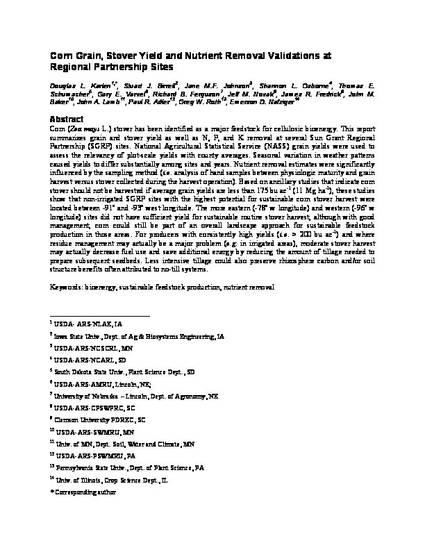
Corn (Zea mays L.) stover has been identified as a major feedstock for cellulosic bioenergy. This report summarizes grain and stover yield as well as N, P, and K removal at several Sun Grant Regional Partnership (SGRP) sites. National Agricultural Statistical Service (NASS) grain yields were used to assess the relevancy of plot-scale yields with county averages. Seasonal variation in weather patterns caused yields to differ substantially among sites and years. Nutrient removal estimates were significantly influenced by the sampling method (i.e. analysis of hand samples between physiologic maturity and grain harvest versus stover collected during the harvest operation). Based on ancillary studies that indicate corn stover should not be harvested if average grain yields are less than 175 bu ac-1 (11 Mg ha-1 ), these studies show that non-irrigated SGRP sites with the highest potential for sustainable corn stover harvest were located between -91º and -93º west longitude. The more eastern (-78º w longitude) and western (-96º w longitude) sites did not have sufficient yield for sustainable routine stover harvest, although with good management, corn could still be part of an overall landscape approach for sustainable feedstock production in those areas. For producers with consistently high yields (i.e. > 200 bu ac-1 ) and where residue management may actually be a major problem (e.g. in irrigated areas), moderate stover harvest may actually decrease fuel use and save additional energy by reducing the amount of tillage needed to prepare subsequent seedbeds. Less intensive tillage could also preserve rhizosphere carbon and/or soil structure benefits often attributed to no-till systems.
Available at: http://works.bepress.com/douglas_karlen/43/

Works produced by employees of the U.S. Government as part of their official duties are not copyrighted within the U.S. The content of this document is not copyrighted.